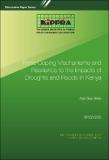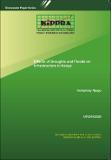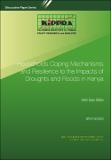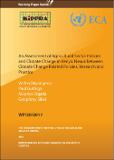Discussion Paper No. 220 of 2020 on Firms Coping Mechanisms and Resilience to the Impacts of Droughts and Floods in Kenya
| dc.date.accessioned | 2020-11-24T05:48:12Z | |
| dc.date.available | 2020-11-24T05:48:12Z | |
| dc.date.issued | 2020 | |
| dc.identifier.uri | http://repository.kippra.or.ke/handle/123456789/2131 | |
| dc.description.abstract | With the climate change predicted to increase, the recurrence and severity of droughts and floods are projected to rise. Building coping mechanisms of firms is crucial in reducing social-economic costs associated with droughts and floods. Scarcity of research on how firms cope with droughts and floods, and factors that affect their resilience remains a hindrance to policy interventions. This study sought to accomplish two objectives; first to understand the coping mechanisms employed by firms in Kenya to manage the impacts of droughts and floods; and second to enrich insights on factors that affect firm resilience to the impacts of droughts and floods. The analyses employed a unique survey of about 800 firms across 27 Kenyan counties in three sectors: Wholesale and retail trade, accommodation and food services, and manufacturing. Descriptive statistics and regression analysis, principally bivariate Probity models and univariate Probity models were used to achieve the objectives of the study. Bivariate Probity Models were preferred for analyzing choices firms make given multiple use of different coping mechanisms. | en |
| dc.language.iso | en | en |
| dc.publisher | The Kenya Institute for Public Policy Research and Analysis (KIPPRA) | en |
| dc.relation.ispartofseries | DP/220/2020; | |
| dc.subject | Firms coping mechanism | en |
| dc.subject | Floods Resilience | en |
| dc.subject | Drought Resilience | en |
| dc.subject | Droughts and Floods | en |
| dc.subject | Kenya | en |
| dc.subject | Climate Change | en |
| dc.title | Discussion Paper No. 220 of 2020 on Firms Coping Mechanisms and Resilience to the Impacts of Droughts and Floods in Kenya | en |
| dc.type | KIPPRA Publications | en |
| ppr.contributor.author | Guyo, Adan |
Files in this item
This item appears in the following Collection(s)
-
Discussion Papers [342]




